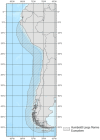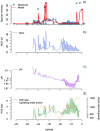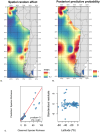Macroecological patterns of planktonic unicellular eukaryotes richness in the Southeast Pacific Ocean
- PMID: 40442169
- PMCID: PMC12122717
- DOI: 10.1038/s41598-025-03220-3
Macroecological patterns of planktonic unicellular eukaryotes richness in the Southeast Pacific Ocean
Abstract
In recent years, studies focusing on microbial biogeography have been developed, but macroecological processes in marine microorganisms remain unclear, especially in seemingly continuous environments such as the Southeast Pacific Ocean (SPO), where information on microbial distribution patterns is limited, and they may vary depending on the habitat and lifestyle. We used unicellular planktonic eukaryotes as model organisms to determine their biogeographic patterns in the SPO, identify the underlying ecological and historical-evolutionary processes and compare with other microorganism groups. Our analyses were based on the Niche Theory to model species diversity distribution using large open-access ecological and physical-biogeochemical databases based on Bayesian approaches, an integrated nested Laplace approximation (INLA), and Generalized Additive Models (GAM). As a result, two richness hotspots were observed, which are associated with coastal and offshore regions in the central southern areas of SPO. The richness hotspots were associated mainly with nutrients (N/Si ratio) and Mixed Layer Depth (MLD), which could be explained by highly productive upwelling events in the SPO. In contrast, the negative correlation of predicted richness with low pH is strongly related to the effect of calcareous shells (tests), as lower pH levels hinder the formation and stability of calcium carbonate shells in protists like foraminifera and radiolaria, thereby affecting overall unicellular planktonic eukaryote diversity. Our results support the role of ecological processes related to productivity, energy dynamics, and ecological limits in shaping broad-scale diversity patterns of unicellular planktonic eukaryotes in the SPO. The results show colonization and extinction dynamics through species replacement (i.e. High Turnover) along the Chilean and Equatorial coasts associated mainly with the Hotspots of their biodiversity, but also a gradual species loss (i.e. High Nestedness) along the Peruvian Coast associated mainly with the Coldspots of their biodiversity; highlighting how local environmental fluctuations can shape these planktonic microorganisms' behavior, ecology and distribution. The distribution patterns of planktonic unicellular eukaryotes show little evidence of the effects of historical and evolutionary processes. This is because the high dispersal capacity of planktonic microbes probably dilutes the influence of these processes in environments lacking clear barriers to species dispersal. Additionally, the effect of historical events could be highlighted in specific taxonomic groups at the kingdom, phylum level or habitat type and addressing gaps about latitudinal richness in the SPO. This provides insight into the spatial distribution of marine microbes and contributes to conservation efforts, as these organisms are an essential foundation of the upper levels of the food web.
Keywords: Biogeographic patterns; Humboldt Current System; Latitudinal gradient; Planktonic microorganisms; Protists; Species diversity distribution.
© 2025. The Author(s).
Conflict of interest statement
Declarations. Competing interests: The authors declare no competing interests.
Figures









Similar articles
-
Prescription of Controlled Substances: Benefits and Risks.2025 Jul 6. In: StatPearls [Internet]. Treasure Island (FL): StatPearls Publishing; 2025 Jan–. 2025 Jul 6. In: StatPearls [Internet]. Treasure Island (FL): StatPearls Publishing; 2025 Jan–. PMID: 30726003 Free Books & Documents.
-
Short-Term Memory Impairment.2024 Jun 8. In: StatPearls [Internet]. Treasure Island (FL): StatPearls Publishing; 2025 Jan–. 2024 Jun 8. In: StatPearls [Internet]. Treasure Island (FL): StatPearls Publishing; 2025 Jan–. PMID: 31424720 Free Books & Documents.
-
Signs and symptoms to determine if a patient presenting in primary care or hospital outpatient settings has COVID-19.Cochrane Database Syst Rev. 2022 May 20;5(5):CD013665. doi: 10.1002/14651858.CD013665.pub3. Cochrane Database Syst Rev. 2022. PMID: 35593186 Free PMC article.
-
Sexual Harassment and Prevention Training.2024 Mar 29. In: StatPearls [Internet]. Treasure Island (FL): StatPearls Publishing; 2025 Jan–. 2024 Mar 29. In: StatPearls [Internet]. Treasure Island (FL): StatPearls Publishing; 2025 Jan–. PMID: 36508513 Free Books & Documents.
-
Survivor, family and professional experiences of psychosocial interventions for sexual abuse and violence: a qualitative evidence synthesis.Cochrane Database Syst Rev. 2022 Oct 4;10(10):CD013648. doi: 10.1002/14651858.CD013648.pub2. Cochrane Database Syst Rev. 2022. PMID: 36194890 Free PMC article.
References
-
- Sutherland, W. J. et al. Identification of 100 fundamental ecological questions. J. Ecol.101, 58–67 (2013).
-
- Geisen, S. et al. Soil protistology rebooted: 30 fundamental questions to start with. Soil Biol. Biochem.111, 94–103 (2017).
-
- Azeem Jadoon, W., Nakai, R. & Naganuma, T. Biogeographical note on Antarctic microflorae: Endemism and cosmopolitanism. Geosci. Front.4, 633–646 (2013).
-
- Geisen, S. et al. Soil protists: A fertile frontier in soil biology research. FEMS Microbiol. Rev.42, 293–323 (2018). - PubMed
MeSH terms
Grants and funding
LinkOut - more resources
Full Text Sources
Research Materials

